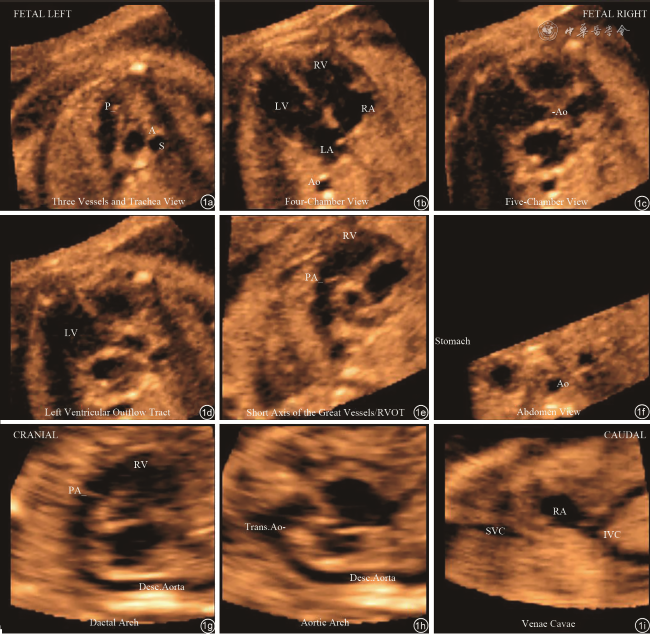资料与方法
一、对象
二、仪器与方法
图1 应用5D Heart联合 VIS-Assistance®技术显示孕23周正常胎儿心脏的9个诊断切面。图a为三血管气管切面;图b为四腔心切面;图c为五腔心切面;图d为左心室流出道切面;图e为右心室流出道切面;图f为胃泡水平腹部横切面;图g为动脉导管弓切面;图h为主动脉弓切面;图i为上下腔静脉右心房切面 |
三、数据记录及分组
四、统计学分析
结果
一、TOF胎儿分组
二、各亚组诊断切面的显示率
表1 不同亚组法洛四联症患儿5D Heart联合VIS-Assistance®技术对各诊断切面的显示率[例(%)] |
| 切面 | 合计(n=57) | 亚组A(n=18) | 亚组B(n=28) | 亚组C(n=11) | χ2值 | P值 |
|---|---|---|---|---|---|---|
| 3VT | 45(78.9) | 12(66.7) | 24(85.7) | 9(81.8) | 2.459 | 0.292 |
| 4CV | 44(77.2) | 12(66.7) | 21(75.0) | 11(100.0) | 4.459 | 0.108 |
| LVOT | 55(96.5) | 18(100.0) | 26(92.9) | 11(100.0) | 2.147 | 0.342 |
| RVOT | 51(89.5) | 16(88.9) | 25(89.3) | 10(90.9) | 0.032 | 0.984 |
| Abdomen/Stomach | 57(100.0) | 18(100.0) | 28(100.0) | 11(100.0) | - | - |
注:3VT为三血管气管切面;4CV为四腔心切面;LVOT为左心室流出道切面;RVOT为右心室流出道切面;Abdomen/Stomach为胃泡切面;-为无数据 |
三、各亚组诊断要素的显示率
表2 不同亚组法洛四联症患儿5D Heart联合VIS-Assistance®技术对各诊断要素的显示率[例(%)] |
| 诊断要素 | 亚组A(n=18) | 亚组B(n=28) | 亚组C(n=11) | χ2值 | P值 |
|---|---|---|---|---|---|
| 3VT | |||||
扩张的主动脉 | 16(88.9) | 28(100.0) | 11(100.0) | 4.491 | 0.106 |
狭窄的肺动脉主干 | 17(94.4) | 27(96.4) | 10(90.9) | 0.487 | 0.784 |
气管 | 13(72.2) | 26(92.9) | 9(81.8) | 3.567 | 0.168 |
上腔静脉 | 16(88.9) | 26(92.9) | 10(90.9) | 0.217 | 0.897 |
| 4CV | |||||
4个房室腔 | 18(100.0) | 28(100.0) | 11(100.0) | - | - |
房室瓣 | 18(100.0) | 28(100.0) | 11(100.0) | - | - |
房室瓣距离 | 17(94.4) | 25(89.3) | 11(100.0) | 1.476 | 0.478 |
卵圆孔瓣 | 12(66.7) | 22(78.6) | 11(100.0) | 4.569 | 0.102 |
十字交叉 | 18(100.0) | 25(89.3) | 11(100.0) | 3.280 | 0.194 |
室间隔 | 18(100.0) | 28(100.0) | 11(100.0) | - | - |
调节束 | 18(100.0) | 28(100.0) | 11(100.0) | - | - |
| LVOT | |||||
室间隔缺损 | 18(100.0) | 26(92.9) | 11(100.0) | 2.147 | 0.342 |
扩张的主动脉 | 18(100.0) | 28(100.0) | 11(100.0) | - | - |
主动脉骑跨 | 18(100.0) | 26(92.9) | 11(100.0) | 2.147 | 0.342 |
| RVOT | |||||
狭窄的肺动脉主干 | 16(88.9) | 25(89.3) | 10(90.9) | 0.032 | 0.984 |
| Abdomen/Stomach | |||||
胃泡 | 18(100.0) | 28(100.0) | 11(100.0) | - | - |
降主动脉 | 18(100.0) | 28(100.0) | 11(100.0) | - | - |
注:3VT为三血管气管切面;4CV为四腔心切面;LVOT为左心室流出道切面;RVOT为右心室流出道切面;Abdomen/Stomach为胃泡切面;-为无数据 |
四、不同年资的2位医师各诊断要素的显示率
表3 医师B、C应用5D Heart联合VIS-Assistance®技术分别两次评价法洛四联症患儿各诊断要素的显示率[例(%)] |
| 诊断要素 | 医师B | 医师C | ||
|---|---|---|---|---|
| 第一次 | 第二次 | 第一次 | 第二次 | |
| 3VT | ||||
扩张的主动脉 | 55(96.5) | 54(94.7) | 54(94.7) | 54(94.7) |
狭窄的肺动脉主干 | 54(94.7) | 56(98.2) | 53(93.0) | 55(96.5) |
气管 | 48(84.2) | 47(82.5) | 40(70.2) | 40(70.2) |
上腔静脉 | 52(91.2) | 50(87.7) | 52(91.2) | 49(86.0) |
| 4CV | ||||
4个房室腔 | 57(100.0) | 57(100.0) | 57(100.0) | 57(100.0) |
房室瓣 | 57(100.0) | 57(100.0) | 57(100.0) | 57(100.0) |
房室瓣距离 | 53(93.0) | 55(96.5) | 53(93.0) | 54(94.7) |
卵圆孔瓣 | 45(78.9) | 45(78.9) | 45(78.9) | 47(82.5) |
十字交叉 | 54(94.7) | 54(94.7) | 55(96.5) | 55(96.5) |
室间隔 | 57(100.0) | 57(100.0) | 57(100.0) | 57(100.0) |
调节束 | 57(100.0) | 57(100.0) | 57(100.0) | 57(100.0) |
| LVOT | ||||
室间隔缺损 | 55(96.5) | 56(98.2) | 55(96.5) | 57(100.0) |
扩张的主动脉 | 57(100.0) | 57(100.0) | 57(100.0) | 57(100.0) |
主动脉骑跨 | 55(96.5) | 56(98.2) | 55(96.5) | 56(98.2) |
| RVOT | ||||
狭窄的肺动脉主干 | 51(89.5) | 52(91.2) | 46(80.7) | 50(87.7) |
| Abdomen/Stomach | ||||
胃泡 | 57(100.0) | 57(100.0) | 57(100.0) | 57(100.0) |
降主动脉 | 57(100.0) | 57(100.0) | 57(100.0) | 57(100.0) |
注:3VT为三血管气管切面;4CV为四腔心切面;LVOT为左心室流出道切面;RVOT为右心室流出道切面;Abdomen/Stomach为胃泡切面 |
五、低年资医师应用5D Heart联合VIS-Assistance®技术的重复性检验结果
表4 医师B应用5D Heart联合VIS-Assistance®技术对法洛四联症患儿各诊断切面进行两次评分的结果[M(P25,P75)] |
| 切面 | 第一次评分 | 第二次评分 | Z值 | P值 |
|---|---|---|---|---|
| 3VT | 2.75(2.50,3.00) | 2.75(2.50,3.00) | -0.228 | 0.820 |
| 4CV | 2.86(2.71,3.00) | 2.86(2.71,3.00) | 0.188 | 0.851 |
| LVOT | 3.00(3.00,3.00) | 3.00(3.00,3.00) | -0.103 | 0.918 |
| RVOT | 3.00(2.00,3.00) | 3.00(2.00,3.00) | -0.746 | 0.456 |
| Abdomen/Stomach | 3.00(3.00,3.00) | 3.00(3.00,3.00) | 0.000 | 1.000 |
注:3VT为三血管气管切面;4CV为四腔心切面;LVOT为左心室流出道切面;RVOT为右心室流出道切面;Abdomen/Stomach为胃泡切面 |
六、高年资医师应用5D Heart联合VIS-Assistance®技术的重复性检验结果
表5 医师C应用5D Heart联合VIS-Assistance®技术对法洛四联症患儿各诊断切面进行两次评分的结果[M(P25,P75)] |
| 切面 | 第一次评分 | 第二次评分 | Z值 | P值 |
|---|---|---|---|---|
| 3VT | 2.75(2.25,3.00) | 2.75(2.25,3.00) | -0.132 | 0.895 |
| 4CV | 2.86(2.71,3.00) | 2.86(2.71,3.00) | -0.280 | 0.779 |
| LVOT | 3.00(3.00,3.00) | 3.00(3.00,3.00) | -0.535 | 0.593 |
| RVOT | 3.00(2.00,3.00) | 3.00(2.00,3.00) | -0.611 | 0.541 |
| Abdomen/Stomach | 3.00(3.00,3.00) | 3.00(3.00,3.00) | 0.000 | 1.000 |
注:3VT为三血管气管切面;4CV为四腔心切面;LVOT为左心室流出道切面;RVOT为右心室流出道切面;Abdomen/Stomach为胃泡切面 |
七、不同年资的两位医师应用5D Heart联合VIS-Assistance®技术的一致性检验
表6 医师B、C应用5D Heart联合VIS-Assistance®技术对法洛四联症患儿各诊断切面的第一次评分结果[M(P25,P75)] |
| 切面 | 医师B评分 | 医师C评分 | Z值 | P值 |
|---|---|---|---|---|
| 3VT | 2.75(2.50,3.00) | 2.75(2.25,3.00) | -0.132 | 0.895 |
| 4CV | 2.86(2.71,3.00) | 2.86(2.71,3.00) | -0.280 | 0.779 |
| LVOT | 3.00(3.00,3.00) | 3.00(3.00,3.00) | -0.535 | 0.593 |
| RVOT | 3.00(2.00,3.00) | 3.00(2.00,3.00) | -0.611 | 0.541 |
| Abdomen/Stomach | 3.00(3.00,3.00) | 3.00(3.00,3.00) | 0.000 | 1.000 |
注:3VT为三血管气管切面;4CV为四腔心切面;LVOT为左心室流出道切面;RVOT为右心室流出道切面;Abdomen/Stomach为胃泡切面 |



